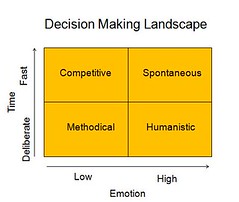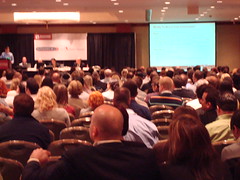The conversions track at SES New York continues to be packed with those wanting to increase the performance of their search marketing campaigns.
The “Converting Visitors into Buyers” panel was moderated by Aaron Shear from Boost Search Marketing and the speakers included: Mike Moran from IBM, Nigel Ravenhill from McAfee, Michael Sack from Idearc Media Corp. and Howard Kaplanfrom Future Now Inc.
I missed the first half of this session but was able to sit in on the second half and hear Mike Sack and Howard Kaplan give the audience ideas on increasing conversions.
Michael Sack started 0ff with a story about why milk is always in the back of the supermarket.
Since milk has a short shelf life, shoppers are more likely to run in and pick some up. Since it is placed at the back of the store, shoppers are more likely to walk past and pick up other tasty items, increasing the overall average purchase.
Milk at the back of the store is not a coincidence, it’s not on purpose. Specifically, brick and mortar stores pay special attention to:
- Orchestrating the experience
- Flow of the store, as it is scientific
- Testing of product placement
Retailers pay special attention to these items because what people see and when they see it can have a direct impact on buying behavior.
Lessons learned from retailers, can be leveraged in the online world, but often times is not. In particular, the following happen all too often on websites:
- Information overkill on the homepage
- Too many links, overlooking the trends in what visitors are most likely looking for
- Confusing navigation that does not match in-store experience
Online offers a dynamic nature of which should be leveraged to its fullest. Too often companies are afraid to test new ideas, move call to actions or update headlines. Encourage them to try however, because the ability to do so is what’s great about websites!
As Mike so nicely summarized, “take advantage of the ability to put the milk anywhere, at any anytime” and measure results.
Howard helped the audience by breaking down the steps to better conversions in easy, bite size chunks.
Before working on conversions, he did a level set on the 4 types of personalities and  where they fall in the decision making landscape.
where they fall in the decision making landscape.
Howard made it easy to relate to by using Seinfeld as an example:
- Kramer – spontaneous
- George – competitive
- Elaine – methodical
- Jerry – humanistic
Marketers should make the effort to view the site through the eyes of their visitors, and their personalities, helping better understand how each interacts with the content.
You can see an eye tracking map for each of the 4 personality types, originally from Nielsen, in a Future Now article by Howard.
Once you are on board with paying attention to the 4 types of personalities, the following steps will get you started:
1. Define conversion goals – What action, what pages and what success looks like. If you are new to conversion goals, create a test pilot on your own website and get used to the data.
2. Define profiles – Howard made a great recommendation to start with logical and emotional and fold in the other two, when possible. Don’t start with so much that your end up discouraged.
3. Do the creative – Create the driving point, i.e. ppc or email, and make sure the message matches the motivation, type of personality and buying process.
These are the pages to test first:
- Highest bounce rate
- Highest exit rate
- Lowest time spent
- Key pages that drive inquiries/sales
The elements on those pages to test include:
- Headlines
- Forms
- Button Size, Shape and Color
This session was really a fantastic starting point for folks looking to get more out of website traffic. In the end it really comes down to crawling out of your comfort zone and testing new/different ideas. All panelists reiterated that results from testing is really the catalyst for lasting changes and bigger, better conversions.



